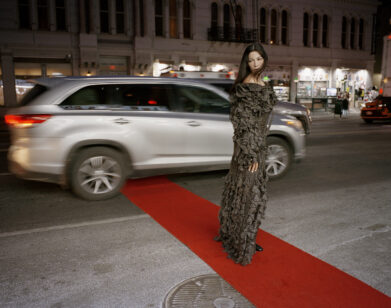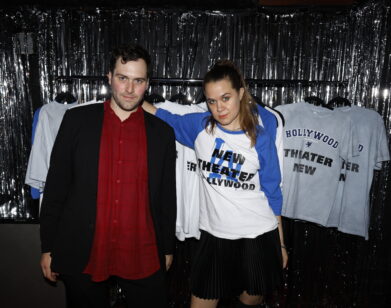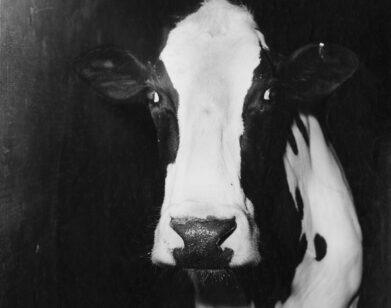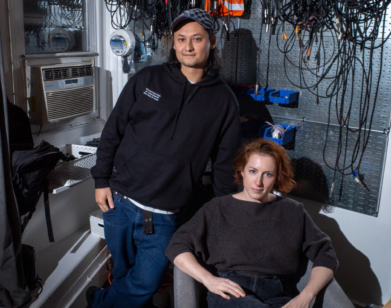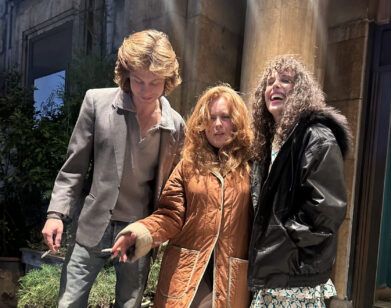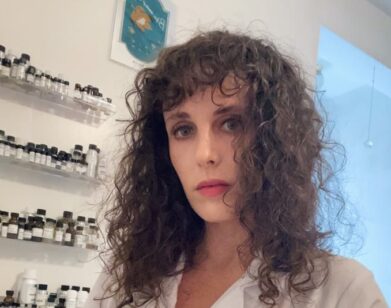OPENING
Joseph Geagan and Ruby McCollister on Birds, Breasts, and Bruegel
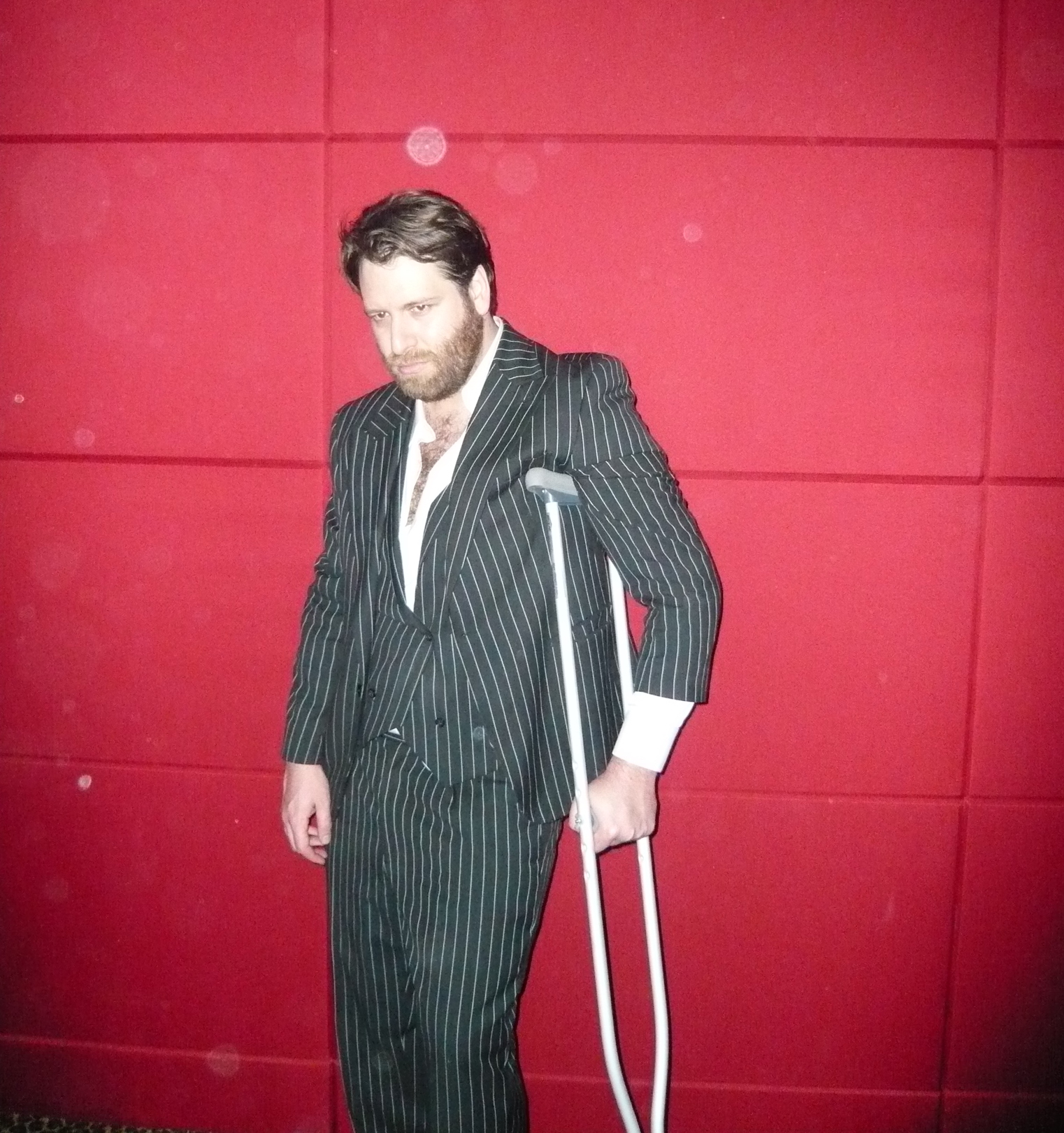
Joseph Geagan, photographed by Gaylord Studios.
Joseph Geagan isn’t concerned with tales of morality in his paintings, but rather tales of “showing off.” Taking a closer look at his new solo show at Lomex Gallery, it’s clear how these two things can become easily confused. His exhibition La Bohème (which borrows it’s name from Giacomo Puccini’s famous opera, which he confirms “was boring”) features paintings that capture lively, carnival-like scenes of decadence and wealth that conceal something far more dysfunctional and degenerate. Squeamish details of nudity, misplaced animals and vacant stares make up the core theme of the show, which is the performance of life and the quandary of wanting to be seen. The opening, which took place earlier this month, was something of a carnival itself, where Joseph hobbled over to Tribeca in crutches to celebrate with friends and other art world figures featured in his paintings, like Dese Escobar, Mykki Blanco, and Ren G. To explain how he got injured and to identify some of the famous figures hiding in his works, Joseph sat down with friend and actress Ruby McCollister to talk shop.
———
RUBY MCCOLLISTER: So here we are, Joseph.
JOSEPH GEAGAN: We’re in Tribeca, honey. [Laughs]
MCCOLLISTER: Who knew you’d make it all the way to Tribeca?
GEAGAN: Not me, so I’m over the moon.
MCCOLLISTER: This is an amazing show.
GEAGAN: Thank you. I’ve never been happy before, and I’m finally happy today.
MCCOLLISTER: That’s really good. Before we launch into this genius work that I’m so excited to talk about, I did notice that you are sporting a limp this morning.
GEAGAN: Oh, yes.
MCCOLLISTER: What’s with that?
GEAGAN: I was chasing after the one person I’ve wanted to be friends with in New York City, Meg Superstar Princess, and I fell into a ditch.
MCCOLLISTER: [Laughs] I’m sure she respected you more because of that.
GEAGAN: Yeah. She said I respect women.
MCCOLLISTER: I love it. I also think you having a limp really goes very well with your painting and your outfit. I mean, you live in, controversially, Los Angeles.
GEAGAN: Supposedly, yeah.
MCCOLLISTER: Which is not really that evident in your work here.
GEAGAN: It’s New York City with palm trees, basically.
MCCOLLISTER: Right. But it’s also ancient France. Joseph, I really admire you for being such an epic American artist, there is something bizarrely European about yourself.
GEAGAN: The show is called La Bohème, and it’s like—
MCCOLLISTER: I actually saw La Bohème for the first time recently at the Met with the Zeffirelli staging, and I was really ready to be so horny, and I was vaguely disappointed by the Zeffirelli staging.
GEAGAN: I saw it years ago. It was boring. [Laughs]
MCCOLLISTER: Except for that one village sequence or whatever, which you were definitely—
GEAGAN: Yeah. That painting was based off of a Bruegel painting, “The Fight Between Carnival and Lent.” This one is kind of the fight between homosexuality and non-homosexuality. [Laughs]
MCCOLLISTER: Right, because this painting that we’re talking about is called “Fight of the Ninnies and Buffoons.”
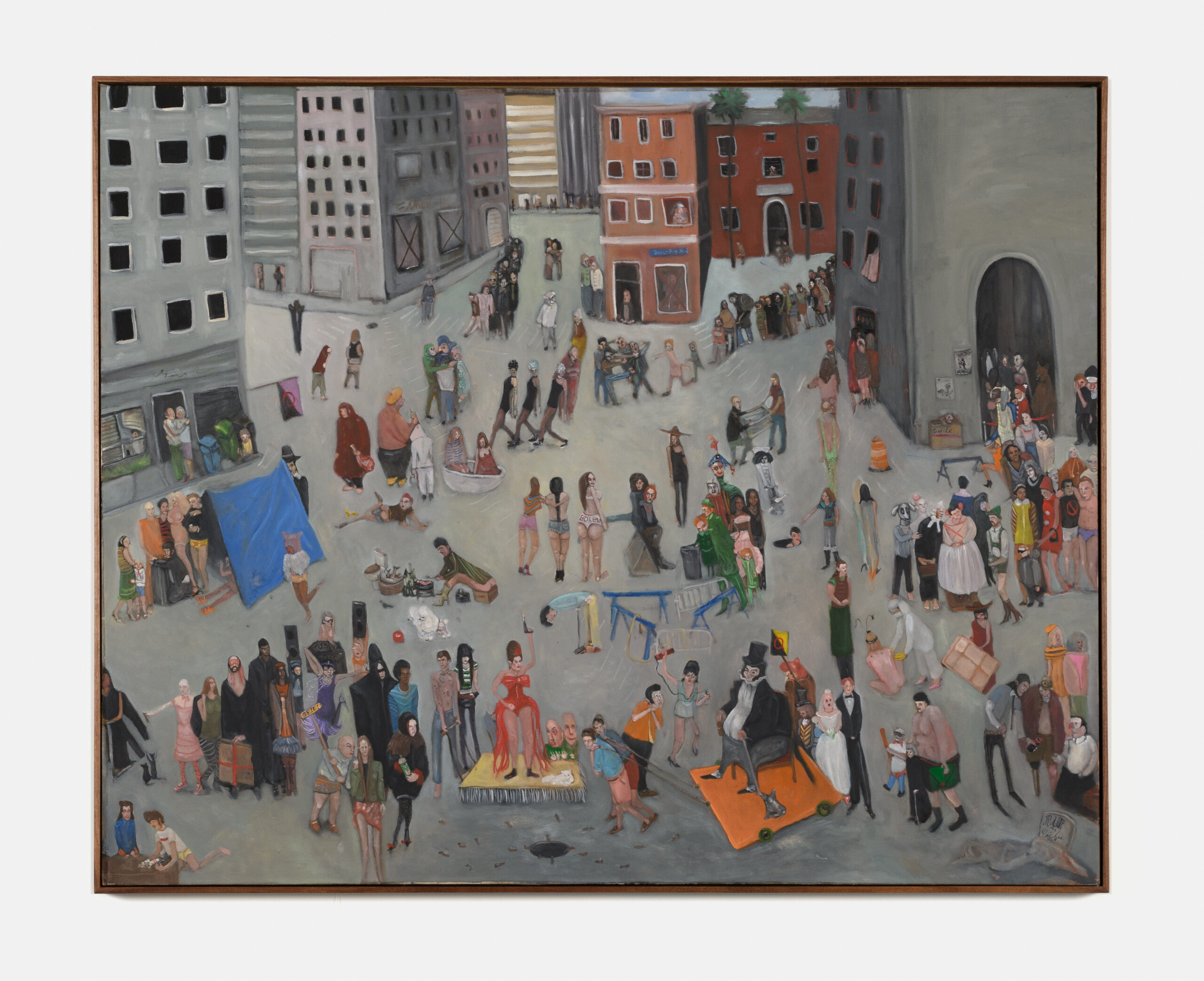
Fight of the Ninnies and Buffoons, 2024. Oil on canvas. 49 x 61 inches. Courtesy of Lomex.
GEAGAN: Correct.
MCCOLLISTER: So I would assume that the ninnies are the homosexuals and the buffoons are the straight people.
GEAGAN: Well, at the end of the day, it’s a mix.
MCCOLLISTER: It’s true. You can be a gay buffoon and a straight ninny. Hello.
GEAGAN: Oh, listen, I’m a gay buffoon.
MCCOLLISTER: And I’m definitely a straight ninny. So there we go. [Laughs] So this Bruegel painting versus the “Fight of the Ninnies and the Buffoons,” is it a morality tale in your case?
GEAGAN: It is not really. It’s kind of a showing off tale.
MCCOLLISTER: A town square, if you will.
GEAGAN: Kind of. I have those two frat bros wearing Oxford shirts and pastel shorts with loafers, it’s like a caricature of a Gilded Age banker.
MCCOLLISTER: Oh, please.
GEAGAN: And then, there’s Joan Crawford and Jared Leto.
MCCOLLISTER: Okay, so what we’re referencing is that in the lower part of the painting on the right side, there’s these two frat bros. They’re characterized with literally coral shorts, which is so—
GEAGAN: And sunglasses on their head. When I was looking into what frat boys do, in all of the pictures, they had sunglasses on the top of their heads.
MCCOLLISTER: They look like ninnies for sure. And then there’s this fat man who doesn’t look like a contemporary fat man.
GEAGAN: It was actually taken pretty directly from a political lampoon cartoon of a robber baron, of Gilded Age-like robber baron from the 1880s. It’s like American capitalism. Fuck that.
MCCOLLISTER: Hello. But there is an aspect of all of your paintings that is sort of psychedelic in terms of you’re seeing every fucking age of a space at once. You are bringing light to the ghost in the room, in parallel time dimensions.
GEAGAN: I really thought about time. And for so many years, as an artist in New York and other places, sentimentality about other eras was kind of seen as silly–
MCCOLLISTER: Twee.
GEAGAN: Yeah, twee. And that is so just truly against how I feel. So I thought about how to meld eras that make sense to me. In the end, it does become New York-specific in a lot of ways.
MCCOLLISTER: Why do you think it becomes New York specific? L.A. is the most haunted space on earth.
GEAGAN: The work is definitely referencing a twenties or thirties or forties Los Angeles, which is directly influenced by New York, because everyone had just come from there. It’s like New York being made again in Los Angeles.
MCCOLLISTER: Okay, so I’m obsessed with this painting, “A Jolly Good Fellow.” Is he the lead singer of Squeeze? He looks very Brit Pop.
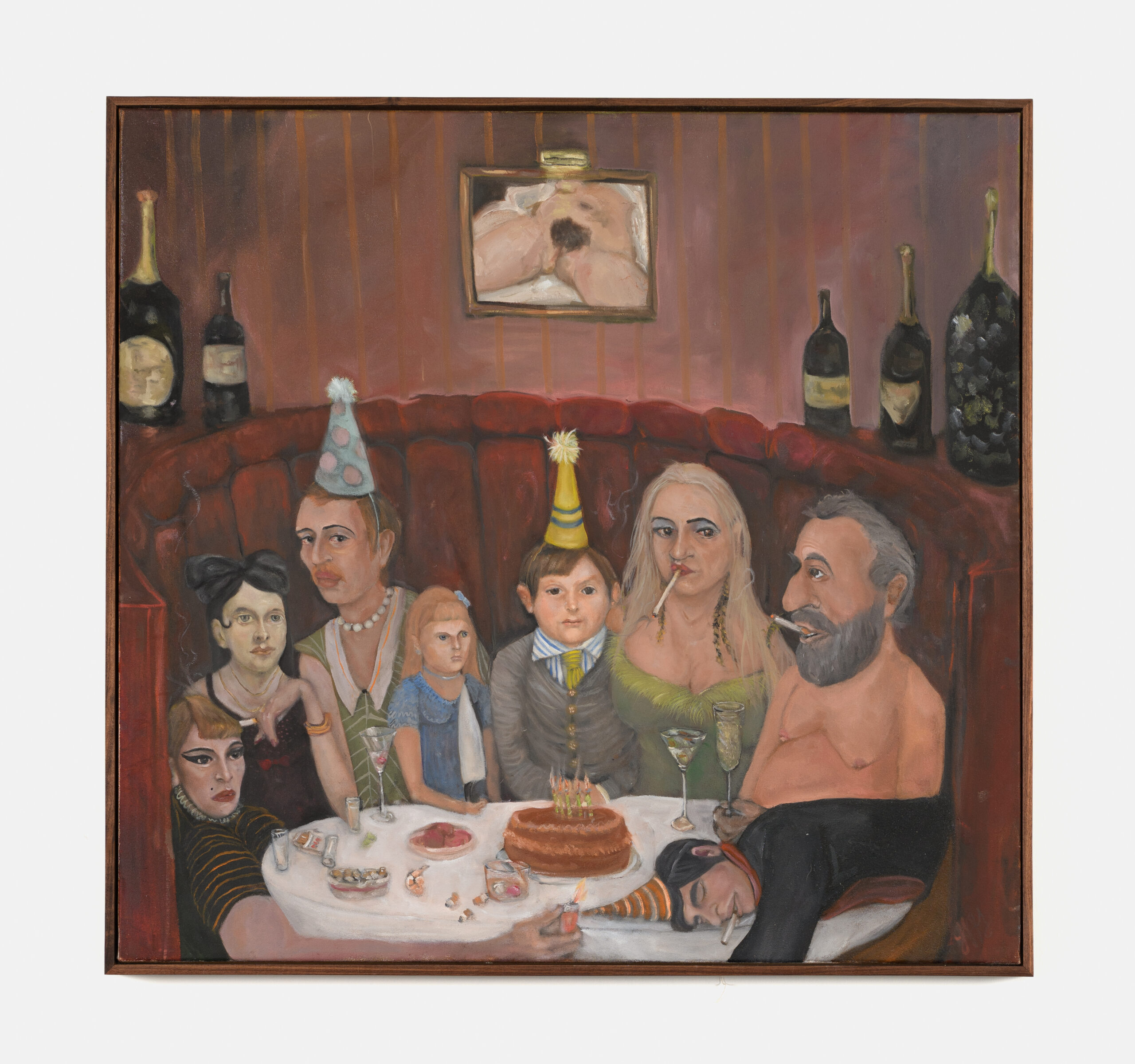
A Jolly Good Fellow, 2024. Oil on canvas. 35 1/8 x 37 inches. Courtesy of Lomex.
GEAGAN: I was Googling, “What did older gay men wear in Palm Springs in 1997?”
MCCOLLISTER: Well, 1997 really was the moment in which the past was left behind and the future began.
GEAGAN: Totally. I think this painting feels very 1997 to me. It’s like, “Sushi’s crazy and new. It’s what gay people eat.:
MCCOLLISTER: And it’s like five pieces, it’s one piece for everybody.
GEAGAN: It’s like, “What time is it? Where are they? Why is this the middle of the day?” I don’t know. I have a lot of birds in the paintings, that’s a theme. And this one has boobs. And he’s kind of disgusted by them.
MCCOLLISTER: It’s like, “Ew, I have this fucking bird with tits.”
GEAGAN: It’s like, “You’re a bird, but she has fucking boobs. Why?”
MCCOLLISTER: Well, that’s interesting, analytically.
GEAGAN: I feel like it’s like people have a bad attitude about birds, but they are so cute.
MCCOLLISTER: Yeah, they definitely do. You love them.
GEAGAN: I love birds. And I think that they’re historically important.
MCCOLLISTER: Say more on that.
GEAGAN: I think that people overlook birds.
MCCOLLISTER: Why do you think that?
GEAGAN: Because people don’t want to accept that they have personalities and are loving.
MCCOLLISTER: Whoa. Because they’re like reptilian or something.
GEAGAN: Yeah, they’re reptilian. But birds are like—
MCCOLLISTER: So beautiful.
GEAGAN: They’re beautiful. They’re chic. They’re charming.
MCCOLLISTER: Yeah. But they’re a little cold too.
GEAGAN: Maybe that’s part of it. Whenever I bring up birds to people, most people have an adverse reaction.
MCCOLLISTER: 100%.
GEAGAN: People are like, “I’m a cat person. I’m a dog person.” I’m like, “I’m a bird person.”
MCCOLLISTER: So the goal is huge cages full of parrots. The Heidi Fleiss effect.
GEAGAN: Yeah. Like Heidi Fleiss.
MCCOLLISTER: Okay. This painting is called—
GEAGAN: “Finale.”
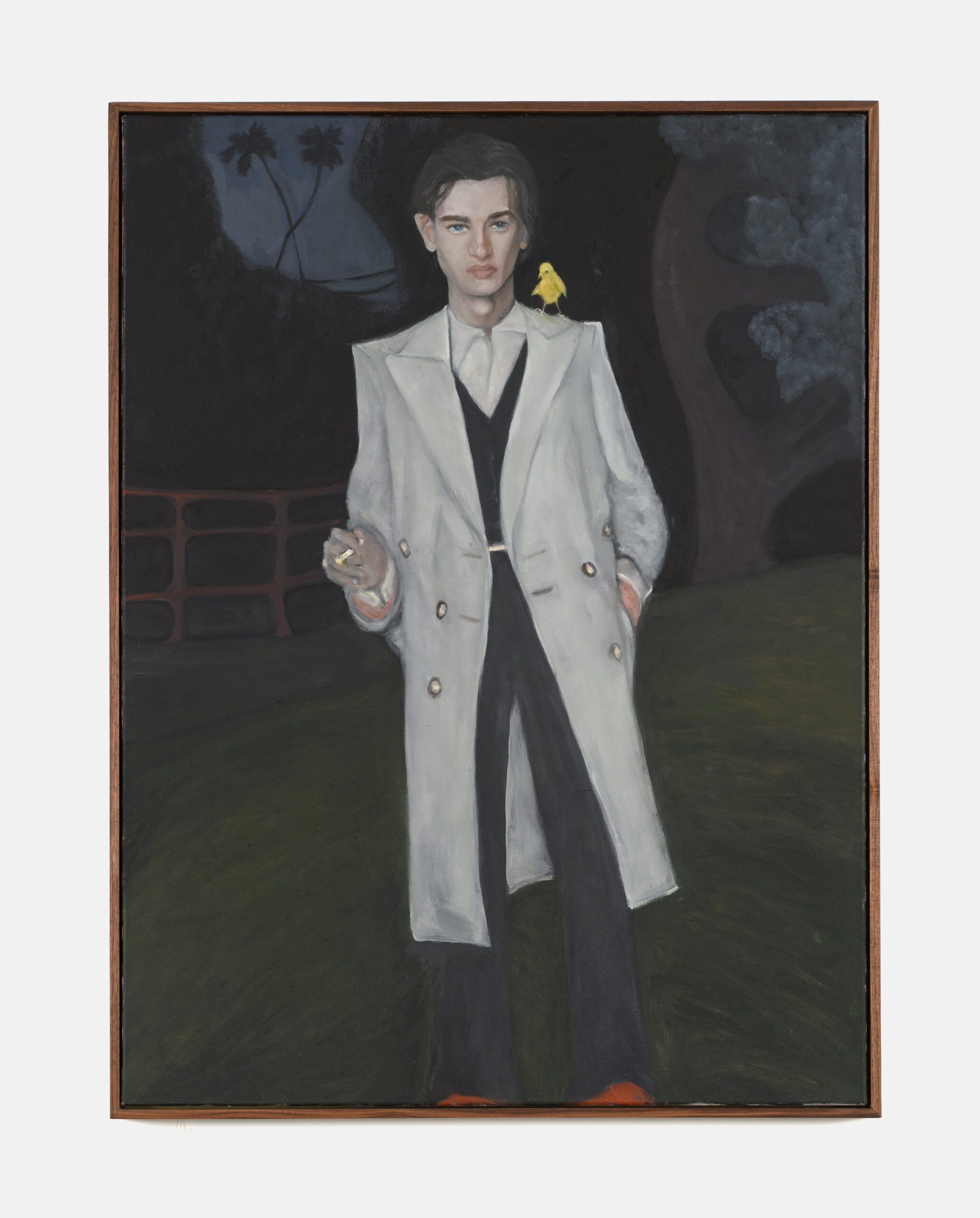
Finale, 2024. Oil on canvas. 41 x 31 1/8 inches. Courtesy of Lomex.
MCCOLLISTER: And it features—
GEAGAN: My boyfriend.
MCCOLLISTER: Your boyfriend, John.
GEAGAN: Tuit. T-U-I-T.
MCCOLLISTER: John Tuit, T-U-I-T. Aquarius.
GEAGAN: Aquarius. It was his birthday yesterday.
MCCOLLISTER: Yes. And you’re a Taurus.
GEAGAN: Technically, I’m a Taurus. But I was born—or you already told me you don’t believe in cusps, so
MCCOLLISTER: Yeah. You are very Taurus to me. So, okay, so this portrait of John, he’s featuring this psychotically amazing outfit and—
GEAGAN: It’s New Year’s Eve.
MCCOLLISTER: But this is an L.A. portrait, definitely, because it’s outside at night.
GEAGAN: It’s the palm trees at nighttime.
MCCOLLISTER: It’s so romantic. I mean, John is devastatingly beautiful, but this portrait is devastatingly beautiful.
GEAGAN: Well, thank you. I really just wanted him to feel like he was part of it, because he’s been such a part of this process too, of me working so crazy and getting this show done, and helping out with everything.
MCCOLLISTER: So your studio is in your apartment?
GEAGAN: In the Gaylord, yeah.
MCCOLLISTER: In the Gaylord
GEAGAN: Of Gaylord Apartments, Los Angeles. [Laughs]
MCCOLLISTER: And so, in this portrait of John, there’s a yellow bird on—
GEAGAN: It’s a chick. Because he’s just youth and age at the same time. It’s like the snake that eats itself—
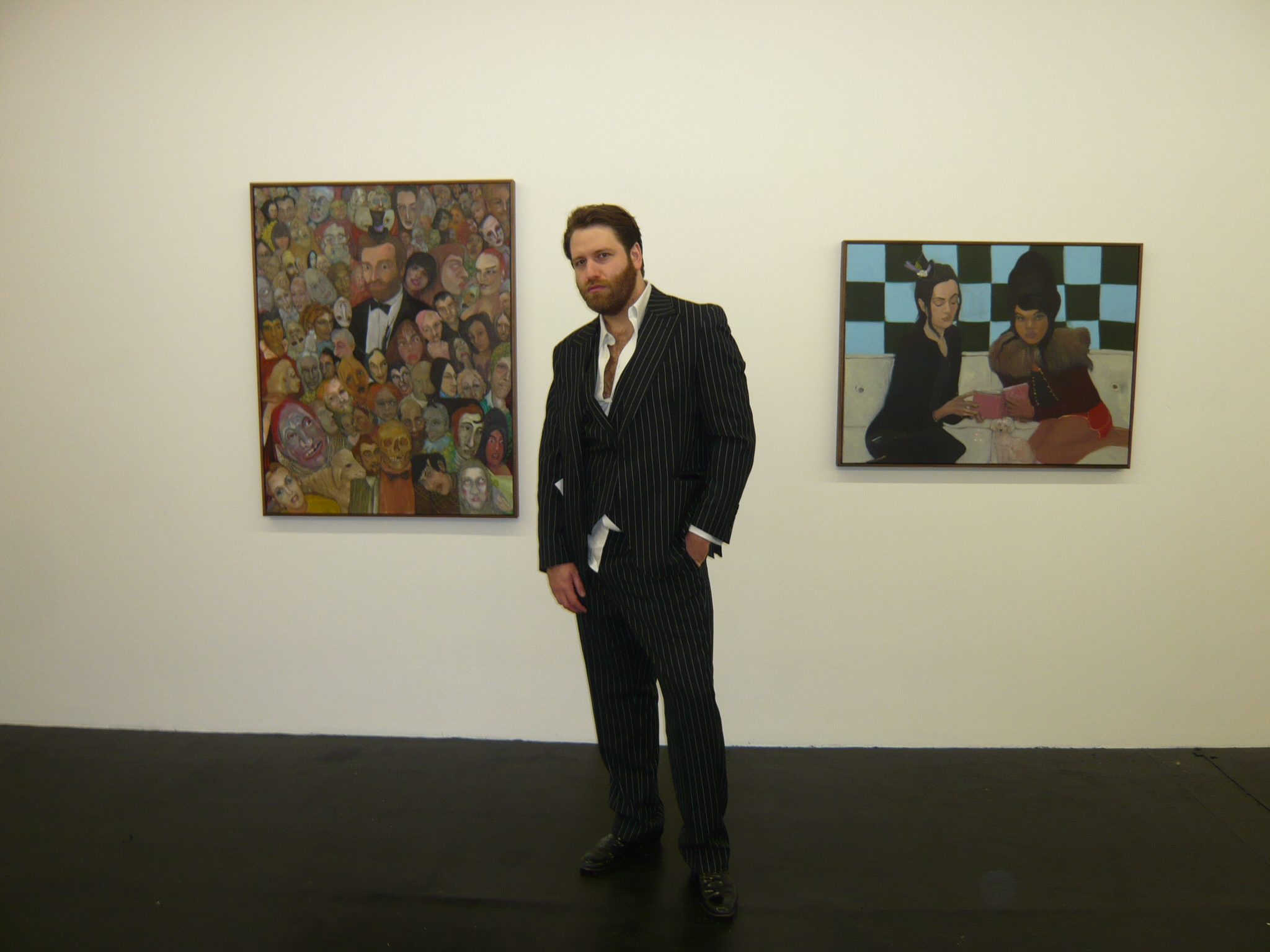
Joseph Geagan, photographed by Gaylord Studios.
Speaker 3: Ouroboros.
GEAGAN: Yeah, Ouroboros. He’s always going to be young. It’s the Los Angeles. It’s nighttime. I don’t know. Something about that. [Laughs]
MCCOLLISTER: Okay. Totally.
GEAGAN: It’s on a grassy hillside, but in L.A. that happens. You’re in the middle of the city, and yet, you can be in a grassy hillside with trees.
MCCOLLISTER: I know, that is what’s really psychedelic about it. I want you to talk about, also, “The Fabulist.”
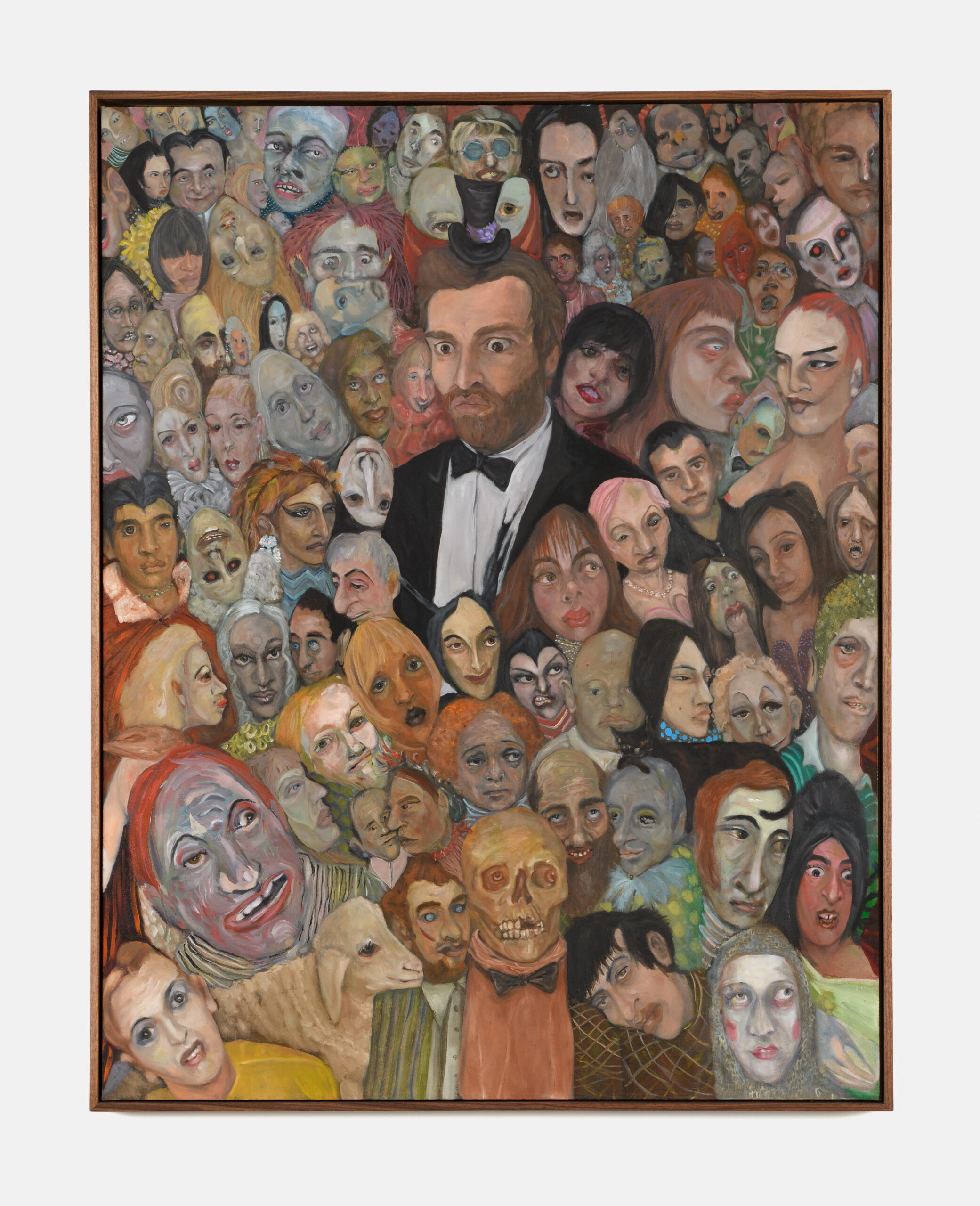
Fabulist, 2024. Oil on linen. 47 1/8 x 37 inches. Courtesy of Lomex.
GEAGAN: So that is kind of a self-portrait of me. And I think there are like, 80 other faces in the painting. It’s based in a sense off of a James Ensor painting who’s been someone that really means a lot to me as artist. His painting was called “Self-Portrait with Masks.” And all the other figures in his painting were wearing masks. I didn’t do that because, for me, all of these paintings have a theatricality to them. It’s a mise en scène. This one is me being manic with all the voices in my head. I have Liza Minnelli coming out of my shoulder. And then, there are faces and figures that don’t really exist. In that painting, I think Liza Minnelli and Mykki Blanco and Michael Alig and Isabella Blow are the only people that are actually real.
MCCOLLISTER: Really? I thought I saw Ada, who is frequently in your paintings.
GEAGAN: Ada is there because I painted her in another painting more fully realized, and I wanted the other one to be more just an impression of Ada.
MCCOLLISTER: And you’re also wearing this little top hat that Ada also wears in another.
GEAGAN: I think the a little top hat with lilacs coming out of it just feels very—
MCCOLLISTER: It’s very clown, right?
GEAGAN: Right. It’s like an homage to a different era and a different idea of what being classy is, but it’s turning it on its head and being like, “We silly as hell.”
MCCOLLISTER: It’s sort of a timeless classic.
GEAGAN: It’s so funny because we were just both featured in the opening of the new Theater Hollywood, and I was asked to do a speech, as was Ruby. And Ruby was not in L.A. at the moment, and sent in a song.
MCCOLLISTER: A voice memo’d song.
GEAGAN: And I was like, “I’ll just do ‘There’s No Business like Show Business.'”
MCCOLLISTER: We sang the same song?
GEAGAN: No, I did a monologue from King Leer. [Laugh]
MCCOLLISTER: No. [Laughs] I was like, “I know Joseph’s going to be there. He will care about me singing ‘There’s No Business like Show Business.'”
GEAGAN: Well, you did so well.
MCCOLLISTER: Thank you. I think you’re one of the only people that I’ve really intimately connected to on the idea of show people.
GEAGAN: It’s their time to shine. This New York thing of being like, “Oh, wear black, I’m miserable. I’m an artist.” No, fuck that. I want to be like, “Dadadadadadada.” That’s the kind of people I want out here.
MCCOLLISTER: Hence the limp.
GEAGAN: Hence the limp. Maybe it’s real, maybe it’s not. We’ll see.
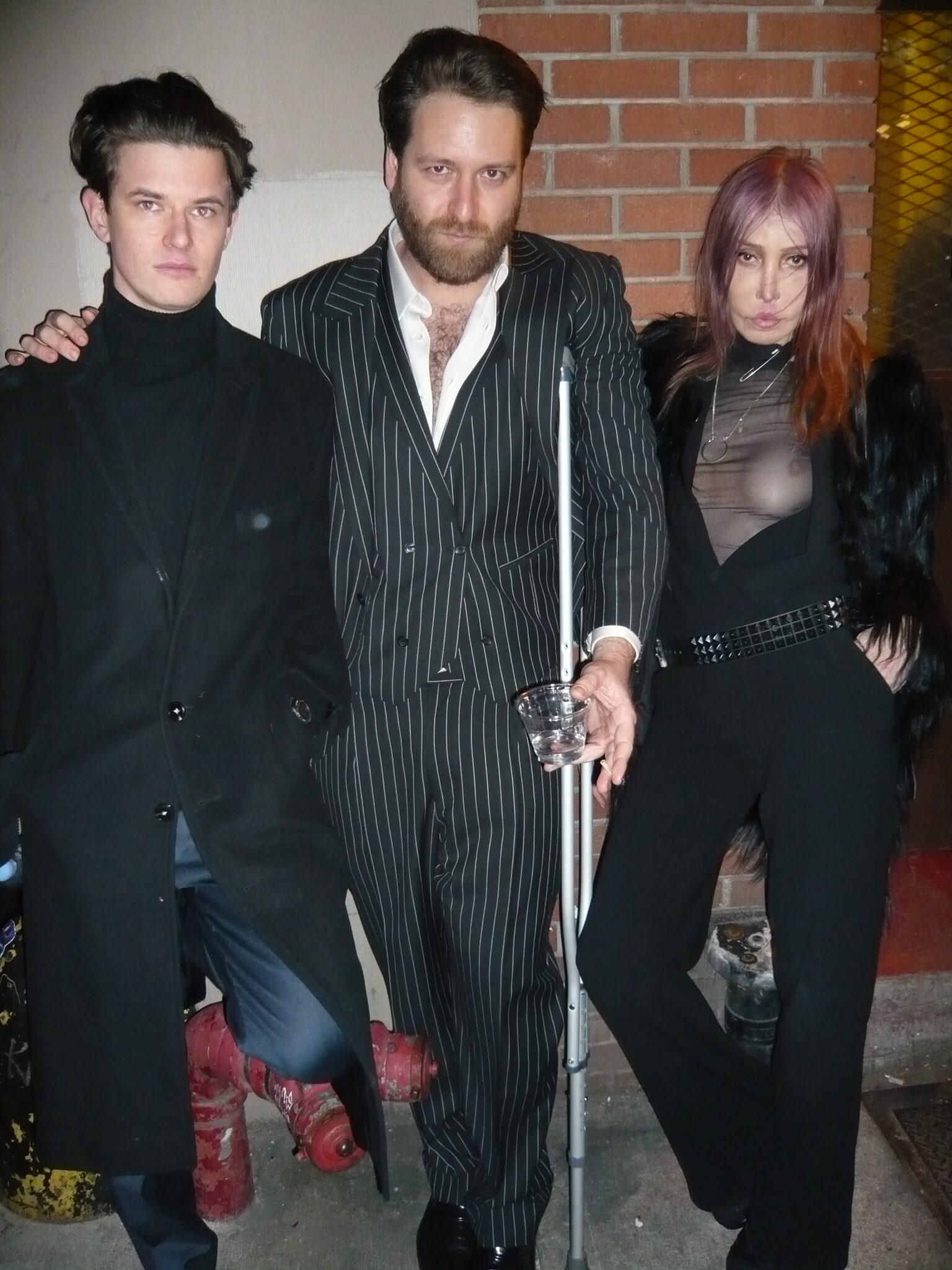
Photographed by Gaylord Studios.

